AP Board Class 11 Chemistry Syllabus 2025-26 – Free PDF Download
The Andhra Pradesh Council, or AP Council, has been hosting exams since 1978 to test students' memory. Previously, there was only one exam per year at the end of the second 12 months. This has since been changed to the current exam schedule for every 11th and 12th grade. The Andhra Pradesh Board of Intermediate Education (BIEAP) publishes the class 11 AP Board syllabus online. Chemistry is one of the toughest subjects, and to help students score good marks, the board publishes the syllabus for each subject, including Chemistry. The AP board 11th Chemistry syllabus 2025-26 aligns with the NCERT textbook. It not only helps with board exam preparation but also prepares students for competitive exams like NEET and JEE.
Also read - Andhra Pradesh Board Class 11 Syllabus 2025-26
Physics Important Formulas for JEE Main/NEET 2027

Chapters in Chemistry Syllabus 2025-26 Class 11 Andhra Pradesh Board
The Andhra Pradesh board follows the NCERT curriculum. Below, we have provided a table with chapters that are present in the AP board book for Class 11 Chemistry. The AP Board 11th Chemistry syllabus is divided into two parts. There are a toatl of 9 units in 11th Chemistry syllabus:
Part 1 covers units like Some Basic Concepts of Chemistry, Structure of Atom, Classification of Elements and Periodicity in Properties, Chemical Bonding and Molecular Structure, Thermodynamics, and Equilibrium.
Part 2 includes Redox Reactions, Organic Chemistry – Some Basic Principles and Techniques and Hydrocarbons.
| Unit | Topics |
| Part 1 | |
| Unit 1: Some Basic Concepts of Chemistry |
|
| Unit 2: Structure of Atom |
|
| Unit 3: Classification of Elements and Periodicity in Properties |
|
| Unit 4: Chemical Bonding and Molecular Structure |
|
| Unit 5: Thermodynamics |
|
| Unit 6: Equilibrium |
|
| Part 2 | |
| Unit 7: Redox Reactions |
|
| Unit 8: Organic Chemistry – Some Basic Principles and Techniques |
|
| Unit 9: Hydrocarbons |
|
Andhra Pradesh Board Class 11 Others subject syllabus:
- AP State Board class 11 Physics syllabus
- AP State Board class 11 Maths syllabus
- AP State Board class 11 Zoology syllabus
- AP State Board class11 Botany syllabus
Some Useful Materials
Along with the syllabus, students are advised to read other NCERT books as well. Below, we have provided some useful materials for the preparation of exams like NEET and JEE Main.
Frequently Asked Questions (FAQs)
Yes in the coming time, whatever decision the Board will take, information will be updated on this page.
Andhra Pradesh Intermediate Examination (11th & 12th class) is referred to as the AP Intermediate Exam.
Subjects that are practical and are all interlinked. Candidates should understand the concepts and remember the formulas. Practice is the key. Candidates must practice subjects like mathematics and physics to have a better understanding of the concept.
Applications for Admissions are open.
As per latest syllabus. Physics formulas, equations, & laws of class 11 & 12th chapters
JEE Main Important Chemistry formulas
Get nowAs per latest syllabus. Chemistry formulas, equations, & laws of class 11 & 12th chapters
JEE Main high scoring chapters and topics
Get nowAs per latest 2024 syllabus. Study 40% syllabus and score upto 100% marks in JEE
JEE Main Important Mathematics Formulas
Get nowAs per latest syllabus. Maths formulas, equations, & theorems of class 11 & 12th chapters
